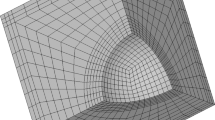Calculation methods for assessing the strength and durability of critical structural elements for various purposes generally assume the isotropy hypothesis of structural materials. At the same time, their technological and operational anisotropy significantly affects the bearing capacity of the entire product. Introducing damageability parameters into the system of governing equations makes it possible to increase the reliability of stress-strain state calculations and assess the durability of structural bearing elements. The use of anisotropic structural materials requires specification of the damageability tensor. The laws governing the influence of anisotropy of mechanical characteristics of metal materials on the kinetics of damage accumulation (scattered fractures) have been established. The results of experimental studies and kinetic damageability diagrams for anisotropic metallic structural materials are presented. A generalized damage accumulation model with consideration of anisotropy parameters has been developed. It allows determining the components of the damageability tensor based on the results of a single basic experiment to measure the degradation of the elastic modulus of a material. The dependence of the limit values of scattered fracture on anisotropy coefficients is shown.





Similar content being viewed by others
References
L. M. Kachanov, Fundamentals of Fracture Mechanics [in Russian], Nauka, Moscow (1974).
Yu. N. Rabotnov, Introduction to Fracture Mechanics [in Russian], Nauka, Moscow (1987).
J. Lemaitre and R. Desmorat, Engineering Damage Mechanics, Springer, Paris (2005).
A. O. Lebedev, M. I. Bobyr, and V. P. Lamashevskyi, Mechanics of Materials [in Ukrainian], National Technical University of Ukraine “KPI”, Kyiv ( 2006).
D. Krajcinovic, Damage Mechanics, Amsterdam (1996).
N. I. Bobyr’ and V. V. Koval’, “Damage contribution to the assessment of the stress-strain state of structure elements,” Strength Mater, 49, 361–368 (2017). https://doi.org/10.1007/s11223-017-9876-2
B. Erice and F. Gálvez, “A coupled elastoplastic-damage constitutive model with Lode Angle dependent failure criterion,” Int J Solid Struct, 51, No. 1, 93–110 (2014). https://doi.org/10.1016/j.ijsolstr.2013.09.015
M. G. Chausov, P. O. Maruschak, V. Hutsaylyuk, et al., “Effect of complex combined loading mode on the fracture toughness of titanium alloys,” Vacuum, 147, 51–57 (2018). https://doi.org/10.1016/j.vacuum.2017.10.010
V. T. Troshchenko and L. A. Khamaza, “Strain–life curves of steels and methods for determining the curve parameters. Part 1. Conventional methods,” Strength Mater, 42, No. 6, 647–659 (2010). https://doi.org/10.1007/s11223-010-9253-x
N. Bonora, “Identification and measurement of ductile damage parameters,” J Strain Anal Eng, 34, No. 6, 463–478 (1999). https://doi.org/10.1243/0309324991513894
Q. M. Li, “Strain energy density failure criterion,” Int J Solid Struct, 38, Nos. 38–39, 6997–7013 (2001). https://doi.org/10.1016/s0020-7683(01)00005-1
V. P. Golub, “Nonlinear continuum damage mechanics and its application to the problems of creep and fatigue,” Prikl. Mekh., No. 3, 34–66 (2000).
A. Darlet and R. Desmorat, “Stress triaxiality and lode angle along surfaces of elastoplastic structures,” Int J Solid Struct, 67–68, 71–83 (2015). https://doi.org/10.1016/j.ijsolstr.2015.03.006
R. Kiran and K. Khandelwal, “A triaxiality and lode parameter dependent ductile fracture criterion,” Eng Fract Mech, 128, 121–138 (2014). https://doi.org/10.1016/j.engfracmech.2014.07.010
J. Betten, “Damage tensors in continuum mechanics,” J Mécanique Théorique Appliquée, No. 1, 13–32 (1983).
C. Y. Tang, W. Shen, L. H. Peng, and T. C. Lee, “Characterization of isotropic damage using double scalar variables,” Int J Damage Mech, 11, No. 1, 3–25 (2002). https://doi.org/10.1106/105678902023194
C. L. Chow and J. Wang, “An anisotropic theory of continuum damage for ductile fracture,” Eng Fract Mech, 27, No. 5, 547–558 (1987).
H. Badreddine, K. Saanouni, and T. D. Nguyen, “Damage anisotropy and its effect on the plastic anisotropy evolution under finite strains,” Int J Solid Struct, 63, 11–31 (2015). https://doi.org/10.1016/j.ijsolstr.2015.02.009
J. W. Ju, “On energy-based coupled elastoplastic damage theories: Constitutive modeling and computational aspects,” Int J Solid Struct, 25, No. 7, 803–833 (1989). https://doi.org/10.1016/0020-7683(89)90015-2
N. R. Hansen and H. L. Schreyer, “A thermodynamically consistent framework for theories of elastoplasticity coupled with damage,” Int J Solid Struct, 31, No. 3, 359–389 (1994). https://doi.org/10.1016/0020-7683(94)90112-0
M. Bobyr, O. Khalimon, and O. Bondarets, “Phenomenological damage models of anisotropic structural materials,” J Mech Eng NTUU KPI, No. 67, 5–13 (2013).
J. Lemaitre, R. Desmorat, and M. Sauzay, “Anisotropic damage law of evolution,” Eur J Mech A-Solid, 19, No. 2, 187–208 (2000). https://doi.org/10.1016/s0997-7538(00) 00161-3
C. Luo, Y. Mou, and R. P. Han, “A large anisotropic damage theory based on an incremental complementary energy equivalence model,” Int J Fracture, 70, No. 1, 19–34(1995). https://doi.org/10.1007/bf00018133
F. Sidoroff, “Description of anisotropic damage application to elasticity,” in: IUTAM Colloquium on Physical Nonlinearities in Structural Analysis, Springer, Berlin (1981), pp. 237–244. https://doi.org/10.1007/978-3-642-81582-9_35
M. Bobyr, O. Khalimon, and O. Bondarets, “Modeling of scattered damage accumulation kinetics under combined stress,” Strength Mater, 44, No. 1, 20–26 (2012). https://doi.org/10.1007/s11223-012-9344-y
Author information
Authors and Affiliations
Corresponding author
Additional information
Translated from Problemy Mitsnosti, No. 5, pp. 86 – 95, September – October, 2023.
Rights and permissions
Springer Nature or its licensor (e.g. a society or other partner) holds exclusive rights to this article under a publishing agreement with the author(s) or other rightsholder(s); author self-archiving of the accepted manuscript version of this article is solely governed by the terms of such publishing agreement and applicable law.
About this article
Cite this article
Bobyr, M.I., Bondarets, O.A. Phenomenological Model of Scattered Fracture for Anisotropic Materials. Strength Mater 55, 945–953 (2023). https://doi.org/10.1007/s11223-023-00585-6
Received:
Published:
Issue Date:
DOI: https://doi.org/10.1007/s11223-023-00585-6




